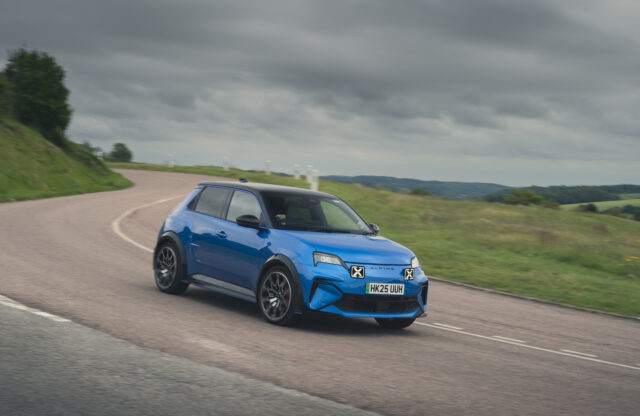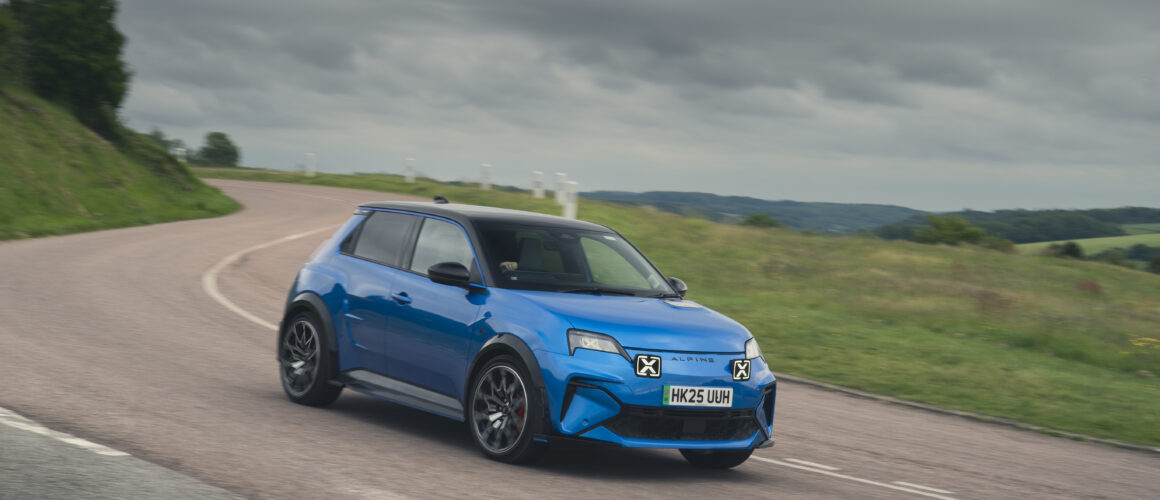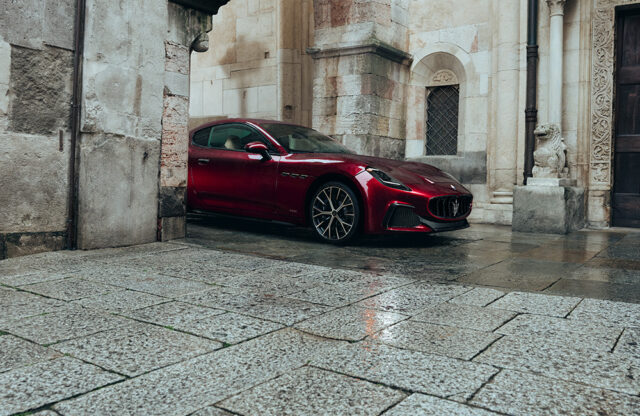There’s been plenty of buzz about the all-electric Alpine A290 ever since it made its dynamic debut at the 2024 Goodwood Festival of Speed. There, the A290’s retro, rally-inspired aesthetics gained widespread admiration, building on the handsome silhouette of the Renault 5 with more muscular bodywork and distinctive faux rally spotlights. While the A290’s ascent up Goodwood’s Hill was silent, anticipation for the car has been anything but.
Perhaps for good reason. If the future really is electric, the A290 appears to answer many enthusiasts’ prayers. It’s compact, simple and relatively lightweight for an EV at 1497kg. With a starting price of just £33,500 for the base-model GT, it’s also relatively affordable. The GTS model tested here offers a WLTP range of 236 miles, meaning it is viable for real-world use without constant charging anxiety. If anyone can make the all-electric hot hatch formula appealing, then it’s the people who created the brilliant A110 sports car.
Adding to the A290’s significance is the fact it is the first in Alpine’s ‘Dream Garage’ – a planned series of all-electric vehicles that also consists of an SUV in the form of the recently unveiled A390, as well as an A110 successor and a yet-to-be-seen four-seater coupé. All of these machines will be built in Alpine’s hometown of Dieppe on the Normandy coast.
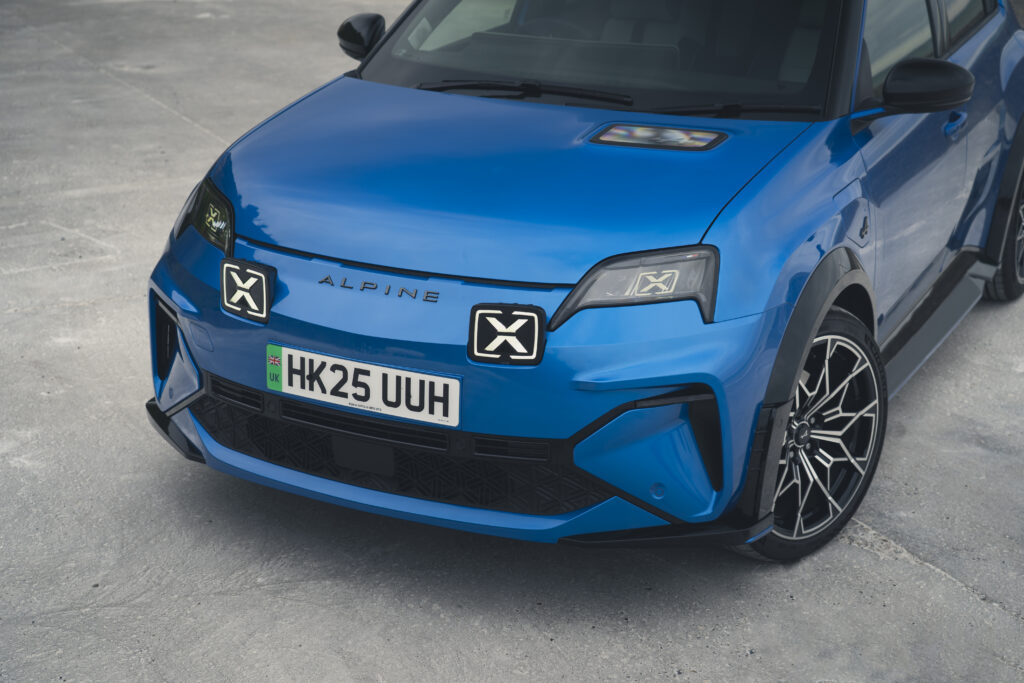
Dieppe is, rather fittingly, precisely where I find myself after being handed the keys to a UK-spec A290 for a test drive. I’m happy to report that this top-of-the-range GTS Premiere Edition looks even better in real life than it does in media imagery – particularly when finished in its signature hue of Alpine Vision Blue. The contrasting black roof and snowflake-inspired 19-inch alloy wheels look great, too.
A walk around the car reveals the many ways that Alpine has attempted to differentiate the A290 from the Renault 5 from which the model is based. To my eyes, the marque has done enough to enhance the car’s presence without resorting to a look that’s overly aftermarket or aggressive. The side-skirts, ducktail spoiler, beefier bumpers and diffuser fit well with the boxy design language of the 5. When the cars are parked side by side, these additions – along with the A290’s 60mm wider track and sportier stance – lend it a far more purposeful appearance.
Open the driver’s door and you’ll find that a similar, if less dramatic, transformation has taken place inside, too. The most obvious features are the A290-specific steering wheel and sports seats, which are both finished in supple Nappa leather in this range-topping example. The seats strike the balance of being both comfortable and supportive, although the steering wheel would transmit better feel to your palms if it was a little thinner.
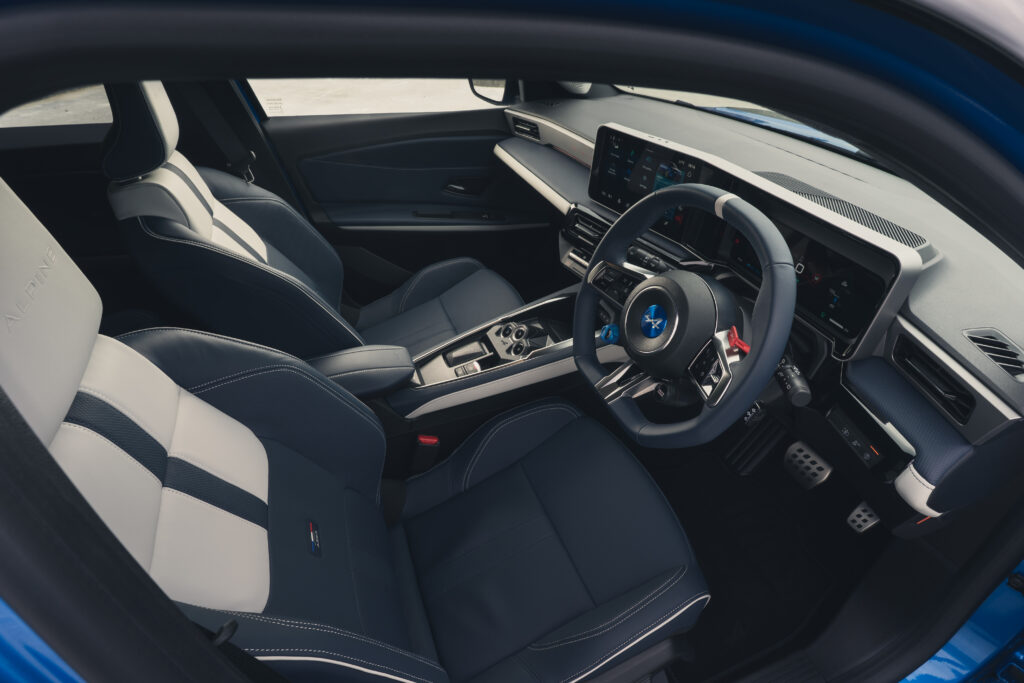
The driving position itself is a little odd. I find myself sitting too high and with the backrest far more reclined than usual – a likely consequence of the ‘skateboard’ chassis design, which positions the driver above the floor-integrated battery pack.
While the driving position isn’t perfect, there’s plenty to like about the rest of the cabin. Unlike in the 5, you’re divided from your passenger by a chunky centre console, which sports the same gear-selection buttons as the A110. The screens are identical to the 5’s and are angled towards the driver, albeit with Alpine-specific software and graphics.
The cabin materials appear premium and – despite being based on the 5 – it all generally feels more special than this car’s £38,510 price tag might suggest. Aside from the driving position, my only other nit-picks are the laggy drive-mode button and the slightly baffling lack of a cup-holder. Predictably for a small hot hatch, rear-seat space is rather poky; at six feet tall, I struggle to sit behind my own driving position and find there is next to no foot space.
You soon forget about such niggles in any hot hatch worth buying. But what about the A290? Well, as with any EV, it boasts punchy acceleration that pins you to your seat more assertively than the 0-62mph time of 6.4 seconds might suggest. The headline power figure is rather modest for an EV, however; this GTS model develops 217bhp, while the entry-level GT makes just 178bhp. If we’ve learned anything from the advent of EVs, though, it’s that supercar-bothering performance figures don’t always make for a great driver’s car.
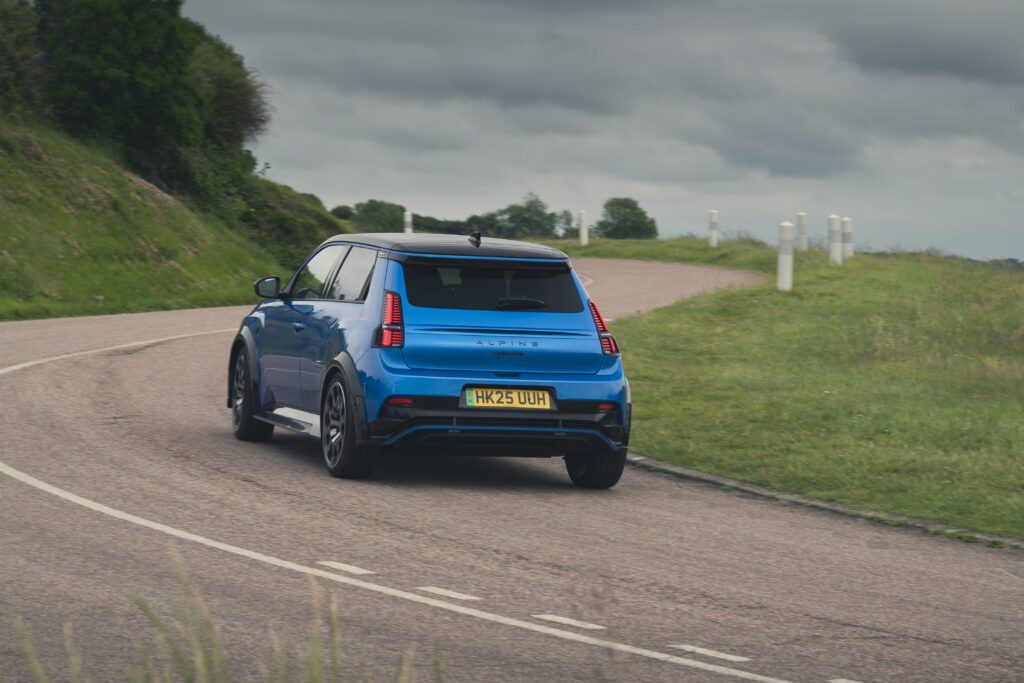
Brilliant suspension, however, is an essential part of the performance car recipe. With MacPherson struts at the front and a multi-link set-up at the rear, the A290 shares its fully independent suspension architecture with the 5 – which is no bad thing. But you’ll be pleased to hear that Alpine has made plenty of modifications. Beefier anti-roll bars, hydraulic bump stops, revised knuckles, a lightened aluminium front subframe plus bespoke springs and dampers work together to hone the handling.
The result is a car that strikes a great balance between compliance and control on the French equivalent of a British B-road. Crests and road imperfections are largely shrugged off – but I suspect the comparably lunar surface of Britain’s provincial Tarmac would provide a sterner test. Still, the balance of this front-wheel-drive hot hatch feels great. The nose is keen, and I reckon the rear would nicely rotate with an abrupt lift of the brake if you were testing the limits of adhesion on a circuit, too.
Going hand-in-hand with the polish of the suspension are the brakes. Brembo calipers from the A110 are paired with 320mm discs and controlled by one of the best brake-by-wire (BBW) systems I’ve experienced. A significant benefit of the BBW system is that the onboard computer can precisely control the torque vectoring by braking, which replaces a traditional limited-slip differential.
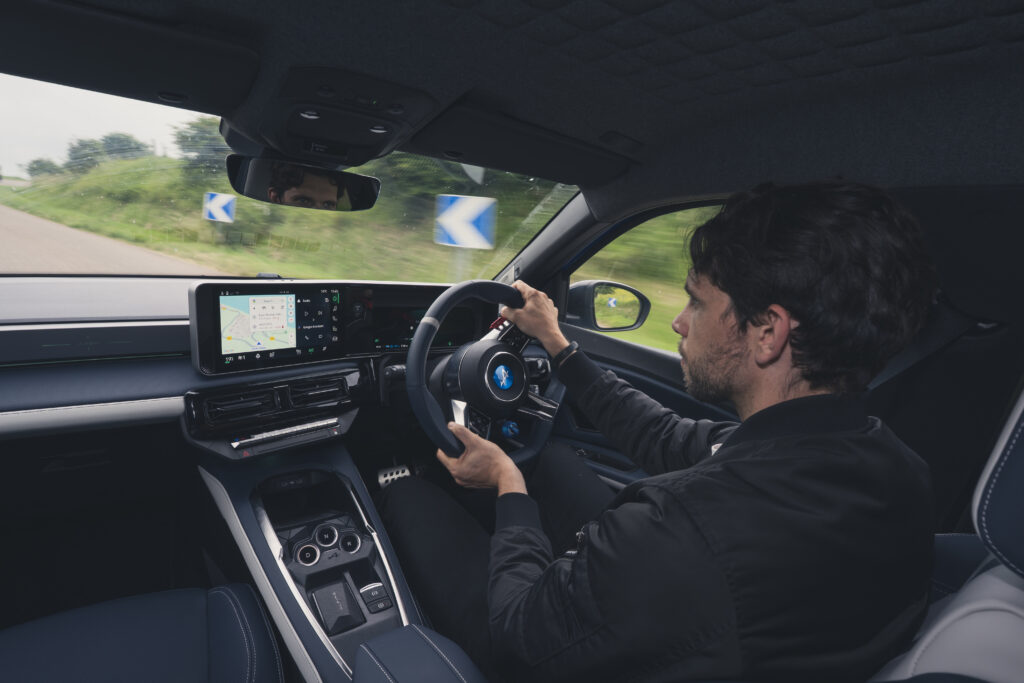
The brakes are strong, with firm, progressive pedal feel that inspires confidence when leaning on the nose into corners. It’s certainly nice to have brakes that feel this organic in an EV. Get back on the throttle and, for the most part, the torque-vectoring system does an admirable job of clawing back front-end grip. That said, the A290 isn’t immune to some wheelspin and torque steer if you give it too much throttle too soon – just like an old-school hot hatch.
Throttle response, steering weight and torque vectoring are all altered by the A290’s four driving modes: Save, Normal, Sport and Personal – each accessed via a button on the steering wheel. Predictably, Save is designed to preserve battery and significantly slackens the throttle response, lightens the steering and reduces the HVAC system’s power consumption. Normal mode sharpens the controls slightly and allows you to bask in the luxury of full-power air-con, while Sport – where I spend most of my time – adds noticeably firmer steering, a sharper throttle and more proactive torque vectoring. Personal mode allows you to select separate settings for the throttle map, steering weight and the motor sound, which rises in pitch with speed in correlation with the motor’s real sound frequencies. The noise isn’t unpleasant, but is a little too PlayStation 1-era Gran Turismo for my tastes.
Gran Turismo was probably the inspiration for the various Challenges you can find in the central touchscreen. These Challenges allow drivers to record acceleration, G-force and lap-time data, which they are then encouraged to try to beat. The Challenges are complemented by a Driver Coaching feature, which teaches drivers how to manage things such as lift-off oversteer, load transfer and so on. While these features are ultimately gimmicks, I can see them adding a fun twist to a track-day outing.
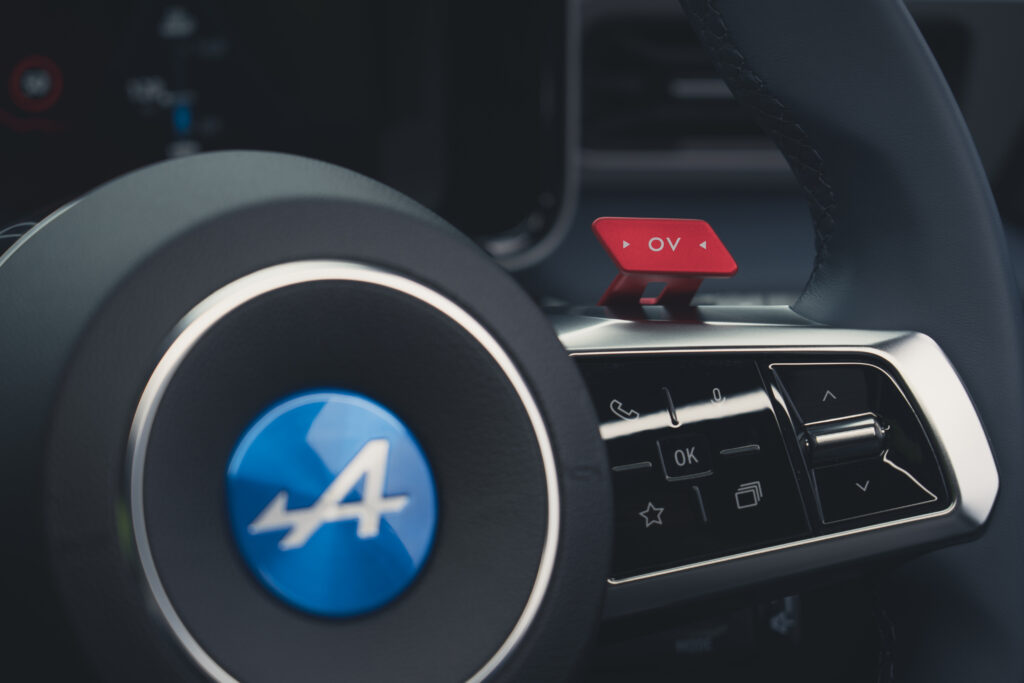
The ‘Overtake’ paddle is a bit of a gimmick, too. Give it a push and the car surges with acceleration for up to ten seconds, but it quickly becomes obvious that it serves exactly the same purpose as the kickdown button hidden under the accelerator pedal. Even so, I commend Alpine for trying to give the car some personality – and it does look cool.
The A290’s spec sheet won’t win a game of Top Trumps these days, but in many ways, this car is all the better for it. Still relatively lightweight and affordable, it blends several old-school hot hatch characteristics with forward-thinking technology, all wrapped in a modern and appealing design. There’s a lot to like here, but I suspect there’s still further to go before hardcore hot hatch fans will swap explosions for electrons without hesitation.
For more information, click here.
